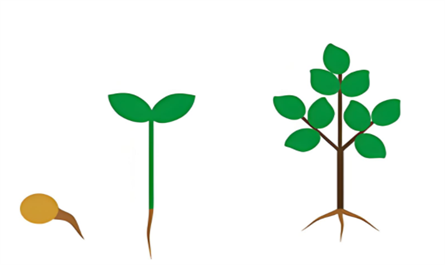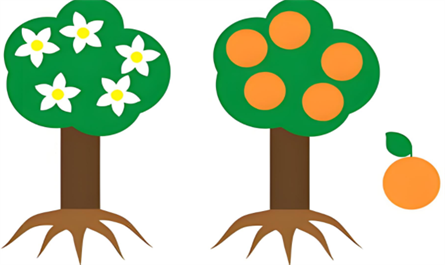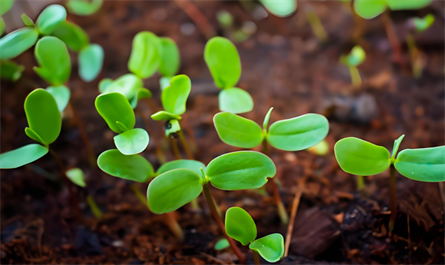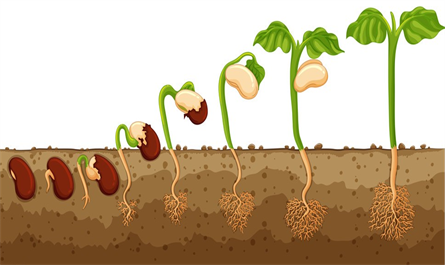Overview of Plant Growth Regulators in horticultural crop cultivation
Types of Plant Hormones
Currently, the recognized plant hormones fall into five main categories: auxins, gibberellins, ethylene, cytokinins, and abscisic acid. In addition, brassinolide, polyamines, salicylic acid, and jasmonic acid also exhibit hormone properties, leading some to classify them into nine categories.
In horticultural crop cultivation, a wide variety of plant growth regulators are used, exceeding 40 types. For example, plant growth promoters include Gibberellic Acid (GA3), Naphthyl Acetic Acid (NAA), Indole Acetic Acid (IAA), Indole-3-Butyric Acid (IBA), and 2,4-D; plant growth inhibitors include abscisic acid, cyanidin, and triiodobenzoic acid; and plant growth retardants include Paclobutrazol (Paclo), Chlormequat Chloride, and Uniconazole.

Functions of Plant Growth Regulators
Plant growth regulators work by activating gene expression, altering cell wall properties and making them porous, thereby inducing cell growth. They can also induce enzyme activity, thereby promoting or inhibiting nucleic acid and protein synthesis. These regulators can also alter certain metabolic pathways, promoting or inhibiting cell division and elongation, and inducing the expression of disease-resistance genes.
Plant growth regulators promote cell elongation, division, and differentiation, thereby accelerating stem growth. They also induce rooting and adventitious root formation, promote flower bud formation, and ultimately lead to larger fruit sets. These regulators also promote callus differentiation and contribute to the formation of apical dominance, thereby inhibiting the growth of lateral buds. They can break dormancy and promote germination. They can also inhibit lateral growth in favor of vertical growth and induce parthenocarpy.
These regulators inhibit stem elongation while increasing the activity of respiratory and cell wall-degrading enzymes. They also promote fruit ripening, leaf and fruit drop, and plant senescence. Furthermore, they break dormancy, promoting bud formation and rooting. On the other hand, plant growth regulators can also promote dormancy in plants, thereby preventing budding.
Planet Growth Regulator Formulation
While exploring how plant growth regulators affect plant growth, it is also important to understand how these regulators are formulated. Different types of regulators must be formulated using appropriate solvents, following strict ratios and methods to ensure effectiveness and safety.
Because different plant growth regulators have different solubility characteristics, it is important to select the appropriate solvent for dissolution. Most plant growth regulators are insoluble in water and are more soluble in organic solvents. Understanding the various formulations of plant growth regulators and their commonly used solvents is crucial during formulation.

Horticultural Application Examples
Seed Germination Regulation
Plant growth regulators such as Gibberellic Acid (GA3) can effectively break dormancy in seeds of citrus, peach, grape, sweet orange, hazelnut, and papaya, promoting germination.
Rooting Promotion Strategies
For grape cuttings, soaking the base of the cuttings in 50mg/L IBA for 8 hours or 50-100ml/L NAA for 8-12 hours significantly promotes rooting. α-NAA can also promote rooting in tomato, eggplant, pepper, and cucumber cuttings.
Fruit Set and Prevention of Flower and Fruit Drop
Spraying apple, pear, and hawthorn cuttings at peak flowering time at a concentration of 25-50mg/L GA3 can effectively increase fruit set. At the same time, for tomatoes, eggplants, peppers and watermelons, spraying 20 mg/L of 2,4-D or 20-40 mg/L of anti-drop agents during their flowering period can also significantly increase the fruit setting rate and effectively prevent the phenomenon of falling flowers and fruits.
Pistillate Flower Induction Technology
Foliar spraying of different concentrations of plant growth regulators at different growth stages of cucumbers can effectively induce or promote the formation of pistillate flowers. Specifically, when cucumber seedlings have 1-3 true leaves, spray 100-200 mg/L of Ethephon.

Seedless Fruit Formation
During the flowering period of hawthorn, spraying 50 mg/L of GA3 effectively induces parthenocarpy, meaning fruit formation occurs directly without fertilization. Similarly, before flowering, dipping grape buds in 200 mg/L of GA3 combined with a small amount of streptomycin solution, followed by dipping the flowers again a week later, can also induce seedless fruit formation.
Fruit Growth and Yield Improvement
The use of plant growth regulators can significantly increase fruit weight. During the peak flowering period of apples, spraying 20 mg/L of BA can increase fruit weight. Furthermore, for pears and peaches, spraying 50 mg/L of auxin when young fruit begins to swell can stimulate further fruit growth. For carrots and radishes, spraying growth regulators during the root enlargement stage of the seedling stage can effectively promote growth and increase root size.
Accelerating Fruit Ripening: Spraying regulators such as ethephon can induce early fruit ripening before the fruit ripens. Spraying apples at an 800-1000 times concentration of ethophon three to four weeks before ripening can effectively accelerate ripening.
Flower and Fruit Thinning Strategies: After the peak flowering period of apples, applying regulators such as NAA can achieve flower and fruit thinning by spraying appropriate amounts of NAA, carbaryl, and 6-BA.
Regulating Stem and Leaf Growth: In May, spraying 2000 mg/L of Paclobutrazol (Paclo) can effectively control new shoot growth in kiwifruit. For spring peach trees, spraying 1000 mg/L of Paclobutrazol (Paclo) when new shoots reach 10-30 cm in length can inhibit excessive shoot growth.
Bolting and Flowering Control
Spraying regulators on celery and lettuce when they have 3-4 true leaves can promote bolting and flowering. For Chinese cabbage, spraying high concentrations of MH at 37 true leaves is recommended to inhibit flower bud differentiation.

Chemical Detasseling Methods
Detassel cucumbers by spraying with Ethephon to promote optimal fruit growth. Foliar spraying with 150-200 mg/L of Ethephon can be started after the first true leaf of the cucumber has unfolded.
Freshness Preservation Techniques
Regulators such as salicylic acid can extend the shelf life of cut flowers and fruit.
Precautions for Use
When applying plant growth regulators, pay attention to crop compatibility, concentration, and timing, and observe environmental and human effects. Ensure that the plant growth regulator is compatible with the target plant to avoid adverse reactions. Follow the correct application method and concentration to ensure safe and effective use. Also, pay attention to the timing and environmental conditions to maximize the effectiveness of the plant growth regulator.
Currently, the recognized plant hormones fall into five main categories: auxins, gibberellins, ethylene, cytokinins, and abscisic acid. In addition, brassinolide, polyamines, salicylic acid, and jasmonic acid also exhibit hormone properties, leading some to classify them into nine categories.
In horticultural crop cultivation, a wide variety of plant growth regulators are used, exceeding 40 types. For example, plant growth promoters include Gibberellic Acid (GA3), Naphthyl Acetic Acid (NAA), Indole Acetic Acid (IAA), Indole-3-Butyric Acid (IBA), and 2,4-D; plant growth inhibitors include abscisic acid, cyanidin, and triiodobenzoic acid; and plant growth retardants include Paclobutrazol (Paclo), Chlormequat Chloride, and Uniconazole.

Functions of Plant Growth Regulators
Plant growth regulators work by activating gene expression, altering cell wall properties and making them porous, thereby inducing cell growth. They can also induce enzyme activity, thereby promoting or inhibiting nucleic acid and protein synthesis. These regulators can also alter certain metabolic pathways, promoting or inhibiting cell division and elongation, and inducing the expression of disease-resistance genes.
Plant growth regulators promote cell elongation, division, and differentiation, thereby accelerating stem growth. They also induce rooting and adventitious root formation, promote flower bud formation, and ultimately lead to larger fruit sets. These regulators also promote callus differentiation and contribute to the formation of apical dominance, thereby inhibiting the growth of lateral buds. They can break dormancy and promote germination. They can also inhibit lateral growth in favor of vertical growth and induce parthenocarpy.
These regulators inhibit stem elongation while increasing the activity of respiratory and cell wall-degrading enzymes. They also promote fruit ripening, leaf and fruit drop, and plant senescence. Furthermore, they break dormancy, promoting bud formation and rooting. On the other hand, plant growth regulators can also promote dormancy in plants, thereby preventing budding.
Planet Growth Regulator Formulation
While exploring how plant growth regulators affect plant growth, it is also important to understand how these regulators are formulated. Different types of regulators must be formulated using appropriate solvents, following strict ratios and methods to ensure effectiveness and safety.
Because different plant growth regulators have different solubility characteristics, it is important to select the appropriate solvent for dissolution. Most plant growth regulators are insoluble in water and are more soluble in organic solvents. Understanding the various formulations of plant growth regulators and their commonly used solvents is crucial during formulation.

Horticultural Application Examples
Seed Germination Regulation
Plant growth regulators such as Gibberellic Acid (GA3) can effectively break dormancy in seeds of citrus, peach, grape, sweet orange, hazelnut, and papaya, promoting germination.
Rooting Promotion Strategies
For grape cuttings, soaking the base of the cuttings in 50mg/L IBA for 8 hours or 50-100ml/L NAA for 8-12 hours significantly promotes rooting. α-NAA can also promote rooting in tomato, eggplant, pepper, and cucumber cuttings.
Fruit Set and Prevention of Flower and Fruit Drop
Spraying apple, pear, and hawthorn cuttings at peak flowering time at a concentration of 25-50mg/L GA3 can effectively increase fruit set. At the same time, for tomatoes, eggplants, peppers and watermelons, spraying 20 mg/L of 2,4-D or 20-40 mg/L of anti-drop agents during their flowering period can also significantly increase the fruit setting rate and effectively prevent the phenomenon of falling flowers and fruits.
Pistillate Flower Induction Technology
Foliar spraying of different concentrations of plant growth regulators at different growth stages of cucumbers can effectively induce or promote the formation of pistillate flowers. Specifically, when cucumber seedlings have 1-3 true leaves, spray 100-200 mg/L of Ethephon.

Seedless Fruit Formation
During the flowering period of hawthorn, spraying 50 mg/L of GA3 effectively induces parthenocarpy, meaning fruit formation occurs directly without fertilization. Similarly, before flowering, dipping grape buds in 200 mg/L of GA3 combined with a small amount of streptomycin solution, followed by dipping the flowers again a week later, can also induce seedless fruit formation.
Fruit Growth and Yield Improvement
The use of plant growth regulators can significantly increase fruit weight. During the peak flowering period of apples, spraying 20 mg/L of BA can increase fruit weight. Furthermore, for pears and peaches, spraying 50 mg/L of auxin when young fruit begins to swell can stimulate further fruit growth. For carrots and radishes, spraying growth regulators during the root enlargement stage of the seedling stage can effectively promote growth and increase root size.
Accelerating Fruit Ripening: Spraying regulators such as ethephon can induce early fruit ripening before the fruit ripens. Spraying apples at an 800-1000 times concentration of ethophon three to four weeks before ripening can effectively accelerate ripening.
Flower and Fruit Thinning Strategies: After the peak flowering period of apples, applying regulators such as NAA can achieve flower and fruit thinning by spraying appropriate amounts of NAA, carbaryl, and 6-BA.
Regulating Stem and Leaf Growth: In May, spraying 2000 mg/L of Paclobutrazol (Paclo) can effectively control new shoot growth in kiwifruit. For spring peach trees, spraying 1000 mg/L of Paclobutrazol (Paclo) when new shoots reach 10-30 cm in length can inhibit excessive shoot growth.
Bolting and Flowering Control
Spraying regulators on celery and lettuce when they have 3-4 true leaves can promote bolting and flowering. For Chinese cabbage, spraying high concentrations of MH at 37 true leaves is recommended to inhibit flower bud differentiation.

Chemical Detasseling Methods
Detassel cucumbers by spraying with Ethephon to promote optimal fruit growth. Foliar spraying with 150-200 mg/L of Ethephon can be started after the first true leaf of the cucumber has unfolded.
Freshness Preservation Techniques
Regulators such as salicylic acid can extend the shelf life of cut flowers and fruit.
Precautions for Use
When applying plant growth regulators, pay attention to crop compatibility, concentration, and timing, and observe environmental and human effects. Ensure that the plant growth regulator is compatible with the target plant to avoid adverse reactions. Follow the correct application method and concentration to ensure safe and effective use. Also, pay attention to the timing and environmental conditions to maximize the effectiveness of the plant growth regulator.
RECENT POSTS
-
Rational Use of Plant Growth Regulators to Promote Fruit Tree Yield and Quality Improvement
-
Combination of Different Plant Growth Regulators with Rooting Hormone
-
Differences and Applications of Zeatin Trans-Zeatin and Trans-Zeatin Riboside
-
14-Hydroxylated brassinolide Supporting Scientific Planting and Application Analysis of Typical Crops
Featured News



